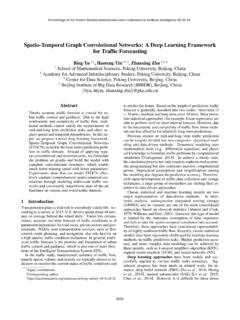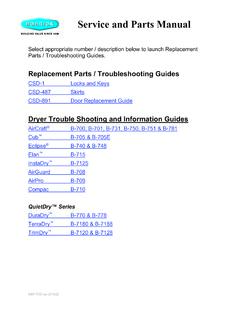Transcription of Convolutional Neural Networks (CNNs / ConvNets)
1 Table of Contents:Architecture OverviewConvNet LayersConvolutional LayerPooling LayerNormalization LayerFully-Connected LayerConverting Fully-Connected Layers to Convolutional LayersConvNet ArchitecturesLayer PatternsLayer Sizing PatternsCase Studies (LeNet / AlexNet / ZFNet / GoogLeNet / VGGNet)Computational ConsiderationsAdditional ReferencesConvolutional Neural Networks (CNNs / ConvNets) Convolutional Neural Networks are very similar to ordinary Neural Networks from the previouschapter: they are made up of neurons that have learnable weights and biases. Each neuronreceives some inputs, performs a dot product and optionally follows it with a non-linearity.
2 Thewhole network still expresses a single differentiable score function: from the raw image pixels onone end to class scores at the other. And they still have a loss function ( SVM/Softmax) on thelast (fully-connected) layer and all the tips/tricks we developed for learning regular NeuralNetworks still what does change? ConvNet architectures make the explicit assumption that the inputs areimages, which allows us to encode certain properties into the architecture. These then make theforward function more e cient to implement and vastly reduce the amount of parameters in OverviewCS231n Convolutional Neural Networks for Visual RecognitionRecall: Regular Neural Nets.
3 As we saw in the previous chapter, Neural Networks receive an input(a single vector), and transform it through a series of hidden layers. Each hidden layer is made upof a set of neurons, where each neuron is fully connected to all neurons in the previous layer, andwhere neurons in a single layer function completely independently and do not share anyconnections. The last fully-connected layer is called the output layer and in classi cationsettings it represents the class Neural Nets don t scale well to full images. In CIFAR-10, images are only of size 32x32x3(32 wide, 32 high, 3 color channels), so a single fully-connected neuron in a rst hidden layer of aregular Neural network would have 32*32*3 = 3072 weights.
4 This amount still seemsmanageable, but clearly this fully-connected structure does not scale to larger images. Forexample, an image of more respectable size, 200x200x3, would lead to neurons that have200*200*3 = 120,000 weights. Moreover, we would almost certainly want to have several suchneurons, so the parameters would add up quickly! Clearly, this full connectivity is wasteful and thehuge number of parameters would quickly lead to over volumes of neurons. Convolutional Neural Networks take advantage of the fact that the inputconsists of images and they constrain the architecture in a more sensible way. In particular, unlikea regular Neural network , the layers of a ConvNet have neurons arranged in 3 dimensions: width,height, depth.
5 (Note that the word depth here refers to the third dimension of an activationvolume, not to the depth of a full Neural network , which can refer to the total number of layers in anetwork.) For example, the input images in CIFAR-10 are an input volume of activations, and thevolume has dimensions 32x32x3 (width, height, depth respectively). As we will soon see, theneurons in a layer will only be connected to a small region of the layer before it, instead of all ofthe neurons in a fully-connected manner. Moreover, the nal output layer would for CIFAR-10 havedimensions 1x1x10, because by the end of the ConvNet architecture we will reduce the full imageinto a single vector of class scores, arranged along the depth dimension.
6 Here is a visualization: Left: A regular 3-layer Neural network . Right: A ConvNet arranges its neurons in three dimensions (width,height, depth), as visualized in one of the layers. Every layer of a ConvNet transforms the 3D input volume toa 3D output volume of neuron activations. In this example, the red input layer holds the image, so its widthand height would be the dimensions of the image, and the depth would be 3 (Red, Green, Blue channels).Layers used to build ConvNetsAs we described above, a simple ConvNet is a sequence of layers, and every layer of a ConvNettransforms one volume of activations to another through a differentiable function.
7 We use threemain types of layers to build ConvNet architectures: Convolutional Layer, Pooling Layer, and Fully-Connected Layer (exactly as seen in regular Neural Networks ). We will stack these layers to forma full ConvNet Architecture: Overview. We will go into more details below, but a simple ConvNet forCIFAR-10 classi cation could have the architecture [INPUT - CONV - RELU - POOL - FC]. In moredetail:INPUT [32x32x3] will hold the raw pixel values of the image, in this case an image of width32, height 32, and with three color channels R,G, layer will compute the output of neurons that are connected to local regions in theinput, each computing a dot product between their weights and a small region they areconnected to in the input volume.
8 This may result in volume such as [32x32x12] if wedecided to use 12 layer will apply an elementwise activation function, such as the thresholding at zero. This leaves the size of the volume unchanged ([32x32x12]).POOL layer will perform a downsampling operation along the spatial dimensions (width,height), resulting in volume such as [16x16x12].FC ( fully-connected) layer will compute the class scores, resulting in volume of size[1x1x10], where each of the 10 numbers correspond to a class score, such as among the 10categories of CIFAR-10. As with ordinary Neural Networks and as the name implies, eachneuron in this layer will be connected to all the numbers in the previous this way, ConvNets transform the original image layer by layer from the original pixel values tothe nal class scores.
9 Note that some layers contain parameters and other don t. In particular, theCONV/FC layers perform transformations that are a function of not only the activations in theinput volume, but also of the parameters (the weights and biases of the neurons). On the otherhand, the RELU/POOL layers will implement a xed function. The parameters in the CONV/FClayers will be trained with gradient descent so that the class scores that the ConvNet computesare consistent with the labels in the training set for each summary:A ConvNet is made up of Layers. Every Layer has a simple API: It transforms an input 3D volumeto an output 3D volume with some differentiable function that may or may not have (0,x)A ConvNet architecture is in the simplest case a list of Layers that transform the imagevolume into an output volume ( holding the class scores)There are a few distinct types of Layers ( CONV/FC/RELU/POOL are by far the mostpopular)Each Layer accepts an input 3D volume and transforms it to an output 3D volume through adifferentiable functionEach Layer may or may not have parameters ( CONV/FC do, RELU/POOL don t)Each Layer may or may not have additional hyperparameters ( CONV/FC/POOL do,RELU doesn t)
10 The activations of an example ConvNet architecture. The initial volume stores the raw image pixels (left) andthe last volume stores the class scores (right). Each volume of activations along the processing path isshown as a column. Since it's di cult to visualize 3D volumes, we lay out each volume's slices in rows. Thelast layer volume holds the scores for each class, but here we only visualize the sorted top 5 scores, andprint the labels of each one. The full web-based demo is shown in the header of our website. Thearchitecture shown here is a tiny VGG Net, which we will discuss now describe the individual layers and the details of their hyperparameters and LayerThe Conv layer is the core building block of a Convolutional network that does most of thecomputational heavy and intuition without brain stuff.















